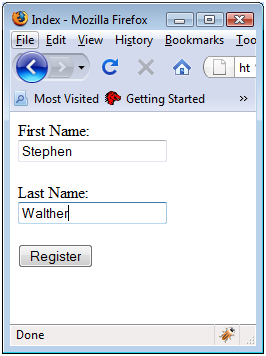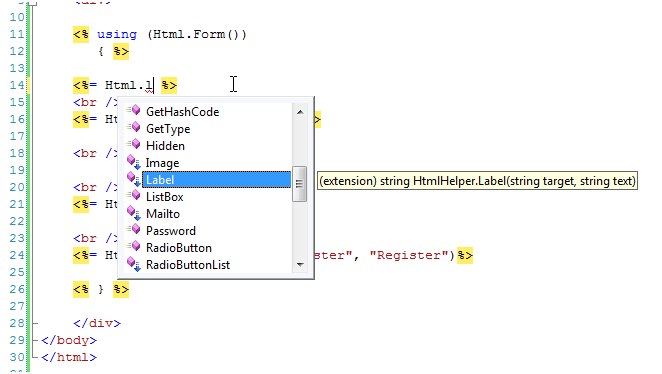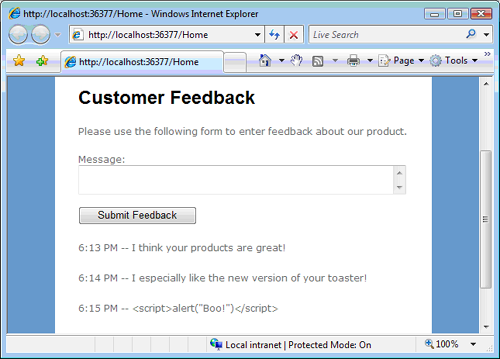Unit Test는 한글 VS 적용이 안되는 점,
IIS 쪽 부분은 다른 블로그 내용이 더 좋은 것 같아 다른 글을 다뤄 볼까 해요.
아직은 어설픈 해석만 하고 있지만 튜토리얼 정리가 끝나고 미니 프로젝트를 다뤄볼까 합니다 :)
Creating Custom HTML Helpers
이 튜토리얼의 목적은 MVC views에서 사용할 수 있는 사용자 정의 HTML Helpers을 어떻게 만드는 지 설명하는 것입니다. HTML Helpers의 장점으로, HTML 태그의 코드 양을 감소할 수 있습니다.
이 튜토리얼의 첫 파트에서, ASP.NET MVC 프레임워크에 내장된 HTML Helpers에 대해 알아 볼 것이고, 다음으로 사용자 정의 HTML Helpers을 만드는 두 가지 메소드를 설명할 것입니다.
Understanding HTML Helpers
HTML Helper은 단순한 string을 리턴 하는 메소드 입니다. String은 사용자가 원하는 여러 타입의 콘텐트를 나타냅니다. 예를 들어, HTML <input>과 <img> 태그와 같이 표준 HTML 태그를 렌더링 할 때 HTML Helpers을 사용할 수 있습니다. 또, 데이터베이스 데이터로부터 HTML table을 만드는 경우와 같이 복잡한 콘텐트를 렌더링 하기 위해서도 사용할 수 있습니다.
ASP.NET MVC 프레임워크는 다음 표준 HTML Helpers을 포함하고 있습니다.
l Html.ActionLink()
l Html.BeginForm()
l Html.CheckBox()
l Html.DropDownList()
l Html.EndForm()
l Html.Hidden()
l Html.ListBox()
l Html.Password()
l Html.RadioButton()
l Html.TextArea()
l Html.TextBox()
예를 들어, 아래의 폼을 생각해 봅시다. 이 폼은 두 개의 표준 HTML Helpers로 렌더링 되었습니다.
|
<%@ Page Language="C#" AutoEventWireup="true" CodeBehind="Index.aspx.cs" Inherits="MvcApplication1.Views.Home.Index"%> <!DOCTYPE html PUBLIC "-//W3C//DTD XHTML 1.0 Transitional//EN" "http://www.w3.org/TR/xhtml1/DTD/xhtml1-transitional.dtd"> <html xmlns= "http://www.w3.org/1999/xhtml "> <head id="Head1" runat="server"> <title>Index</title> </head> <body> <div> <% using (Html.BeginForm()) { %> <label for="firstName">First Name:</label> <br /> <%= Html.TextBox("firstName")%> <br /><br /> <label for="lastName">Last Name:</label> <br /> <%= Html.TextBox("lastName")%> <br /><br /> <input type="submit" value="Register" /> <% } %> 1 </div> </body> </html> |
Html.BeginForm() Helper 메소드는 HTML <form> 태그의 시작과 끝을 만드는데 사용된다. Html.BeginForm() 메소드는 using 문안에서 호출 되어 진다는 것을 명심해야 합니다. Using 문은 <form> 태그가 using 블록의 끝에서 닫히게 되는 것을 보장해줍니다.
Using 블록을 만드는 것 대신에, <form> 태그를 닫기 위해 Html.EndForm() Helper 메소드를 호출 할 수도 있습니다. 사용자가 편한 방법으로 <form> 태그를 닫고 여는 방법을 선택할 수 있습니다.
위 코드에서 Html.TextBox() Helper 메소드는 Html <input> 태그를 렌더링 합니다. 웹 브라우저에서 소스 보기를 한다면 아래와 같은 코드를 볼 것입니다.
중요! Html.TextBox() Html Helper은 <$ $> 태그가 아니라 <$= $> 태그 내에서 렌더링 됩니다. ‘=’ 기호가 포함되어 있지 않다면, 브라우저에서 렌더링 되지 않을 것입니다.
|
<%@ Page Language="C#" AutoEventWireup="false" CodeBehind="Index.aspx.cs" Inherits="MvcApplication1.Index" %> <!DOCTYPE html PUBLIC "-//W3C//DTD XHTML 1.0 Transitional//EN" "http://www.w3.org/TR/xhtml1/DTD/xhtml1-transitional.dtd"> <html xmlns="http://www.w3.org/1999/xhtml"> <head> <title>Index</title> </head> <body> <div> <form action="http://localhost:33102/" method="post"> <label for="firstName">First Name:</label> <br /> <input id="firstName" name="firstName" type="text" value="" /> <br /><br /> <label for="lastName">Last Name:</label> <br /> <input id="lastName" name="lastName" type="text" value="" /> <br /><br /> <input id="btnRegister" name="btnRegister" type="submit" value="Register" /> </form> </div> </body> </html> |
ASP.NET MVC 프레임워크의 helper은 소규모 이기에, 대부분 사용자들은 사용자 정의 HTML Helpers 로 확장하기를 원할 것입니다.
Creating HTML Helpers with Static Methods
새로운 HTML Helper을 만드는 가장 쉬운 방법은 문자를 리턴 하는 static 메소드를 만드는 것입니다. 예를 들어, HTML <label> 태그를 렌더링 하는 새로운 HTML Helper을 만든다고 생각해 봅시다. 사용자는 <label>을 렌더링 하기 위한 아래 코드의 클래스를 사용할 수 있습니다.
|
using System; namespace MvcApplication1.Helpers { public class LabelHelper { public static string Label(string target, string text) { return String.Format("<label for='{0}'>{1}</label>", target, text); } } } |
위 코드에서 클래스에 관해 특별한 것이 없습니다. Label() 메소드는 단지 문자를 리턴 합니다.
아래 코드에서 수정된 Index view은 HTML <label> 태그를 렌더링 하기 위해 LabelHelper을 사용합니다.
주의! <%@ Import Namespace="MvcApplication1.Helpers" %>
|
<%@ Page Language="C#" AutoEventWireup="true" CodeBehind="Index2.aspx.cs" Inherits="MvcApplication1.Views.Home.Index2"%> <%@ Import Namespace="MvcApplication1.Helpers" %> <!DOCTYPE html PUBLIC "-//W3C//DTD XHTML 1.0 Transitional//EN" "http://www.w3.org/TR/xhtml1/DTD/xhtml1-transitional.dtd"> <html xmlns="http://www.w3.org/1999/xhtml" > <head id="Head1" runat="server"> <title>Index2</title> </head> <body> <div> <% using (Html.BeginForm()) { %> <%= LabelHelper.Label("firstName", "First Name:") %> <br /> <%= Html.TextBox("firstName")%> <br /><br /> <%= LabelHelper.Label("lastName", "Last Name:") %> <br /> <%= Html.TextBox("lastName")%> <br /><br /> <input type="submit" value="Register" /> <% } %> </div> </body> </html> |
Creating HTML Helpers with Extension Methods
사용자가 확장 메소드를 만들 필요가 생길 때, ASP.NET MVC 프레임워크에 포함된 표준 HTML Helpers 처럼 동작하는 HTML Helpers을 만드 -----------
확장 메소드는 존재하는 클래스에 새로운 메소드를 추가하여 활성화 할 수 있습니다. HTML Helper 메소드를 만들 때, view의 Html 프로퍼티를 통해 HtmlHelper 클래스에 새로운 메소드를 추가합니다.
아래 코드의 클래스는 Label() 이라는 이름의 HtmlHelper 클래스에 확장 메소드를 추가합니다. 이 클래스에 관해 주의해야 할 사항이 있습니다. 첫 번째는 이 클래스는 static 클래스이기에 사용자는 static 클래스 내에서 확장 메소드를 정의 해야 합니다.
두 번째로 Label() 메소드의 첫 번째 파라메터는 this 키워드에 의해 선행되어 짐을 알아야 합니다. 확장 메소드의 첫 번째 파라메터는 새로운 확장 메소드가 들어가는 클래스를 의미 합니다.
|
using System; using System.Web.Mvc; namespace MvcApplication1.Helpers { public static class LabelExtensions { public static string Label(this HtmlHelper helper, string target, string text) { return String.Format("<label for='{0}'>{1}</label>", target, text); } } } |
사용자는 확장 메소드를 만들고 성공적으로 어플리케이션을 빌드 했으면, 확장 메소드는 아래와 같이 Visual Studio Intellisense 에 나타날 것입니다.
아래 코드에서 수정된 Index view은 <label> 태그를 렌더링 할 Html.Label() 확장 메소드를 사용합니다.
|
<%@ Page Language="C#" AutoEventWireup="true" CodeBehind="Index3.aspx.cs" Inherits="MvcApplication1.Views.Home.Index3" %> <%@ Import Namespace="MvcApplication1.Helpers" %> <!DOCTYPE html PUBLIC "-//W3C//DTD XHTML 1.0 Transitional//EN" "http://www.w3.org/TR/xhtml1/DTD/xhtml1-transitional.dtd"> <html xmlns="http://www.w3.org/1999/xhtml" > <head id="Head1" runat="server"> <title>Index3</title> </head> <body> <div> <% using (Html.BeginForm()) { %> <%= Html.Label("firstName", "First Name:") %> <br /> <%= Html.TextBox("firstName")%> <br /><br /> <%= Html.Label("lastName", "Last Name:") %> <br /> <%= Html.TextBox("lastName")%> <br /><br /> <input type="submit" value="Register" /> <% } %> </div> </body> </html> |


 [ASP.NETMVC]09.CreatingCustomHTMLHelpers.docx
[ASP.NETMVC]09.CreatingCustomHTMLHelpers.docx




